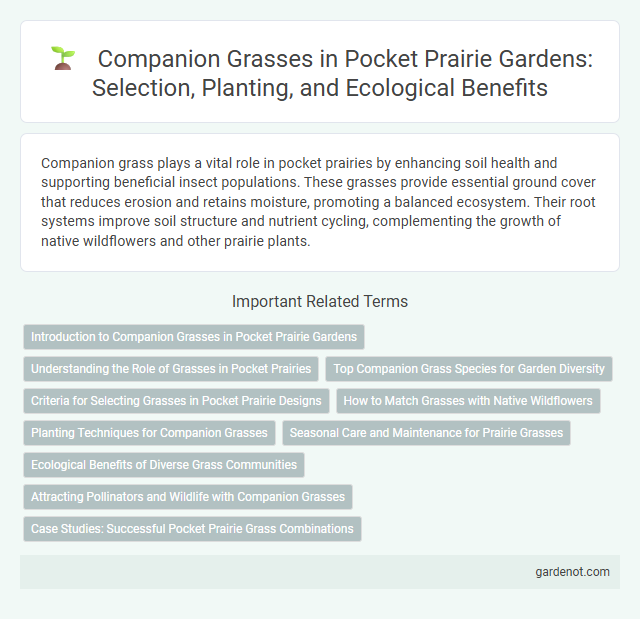Companion grass plays a vital role in pocket prairies by enhancing soil health and supporting beneficial insect populations. These grasses provide essential ground cover that reduces erosion and retains moisture, promoting a balanced ecosystem. Their root systems improve soil structure and nutrient cycling, complementing the growth of native wildflowers and other prairie plants.
Introduction to Companion Grasses in Pocket Prairie Gardens
Companion grasses in pocket prairie gardens enhance biodiversity by providing habitat and food sources for beneficial insects and pollinators. These grasses improve soil health through deep root systems that increase aeration and nutrient cycling. Selecting native species like little bluestem or switchgrass supports ecosystem resilience and requires minimal maintenance in sustainable garden designs.
Understanding the Role of Grasses in Pocket Prairies
Companion grasses in pocket prairies play a crucial role in soil stabilization, moisture retention, and providing habitat for beneficial insects. Species such as Little Bluestem (Schizachyrium scoparium) and Switchgrass (Panicum virgatum) enhance biodiversity by supporting pollinators and improving nutrient cycling. Their deep root systems contribute to carbon sequestration and prevent erosion, making grasses essential for the sustainability of pocket prairie ecosystems.
Top Companion Grass Species for Garden Diversity
Top companion grass species for pocket prairie gardens include Little Bluestem (Schizachyrium scoparium), Switchgrass (Panicum virgatum), and Prairie Dropseed (Sporobolus heterolepis), which enhance biodiversity and support pollinators. These native grasses provide habitat, improve soil health, and create structural diversity within the garden ecosystem. Incorporating diverse companion grasses strengthens ecosystem resilience and promotes sustainable garden practices.
Criteria for Selecting Grasses in Pocket Prairie Designs
Companion grasses in pocket prairie designs must exhibit drought tolerance, native species compatibility, and adaptability to local soil conditions for optimal growth and ecosystem support. Selecting grasses with deep root systems, such as little bluestem (Schizachyrium scoparium) or sideoats grama (Bouteloua curtipendula), enhances soil stability and moisture retention. These species promote biodiversity by providing habitat and food resources for pollinators and wildlife.
How to Match Grasses with Native Wildflowers
Companion grasses in pocket prairies enhance biodiversity by providing structure and habitat while complementing native wildflowers through similar growth patterns and ecological needs. Matching grasses like little bluestem or switchgrass with wildflowers such as black-eyed Susan or wild bergamot ensures synchronized blooming periods and soil preferences, promoting mutual support and pollinator attraction. Selecting grasses and wildflowers adapted to local climate and soil conditions maximizes resilience and ecosystem stability in pocket prairie restorations.
Planting Techniques for Companion Grasses
Companion grasses in pocket prairies enhance biodiversity and soil health through strategic planting techniques such as interseeding and staggered sowing times to optimize growth and resource use. Selecting native species suited to the local climate and soil conditions improves establishment success and supports pollinators and beneficial insects. Proper seedbed preparation, including shallow tilling and moisture management, ensures higher germination rates and stronger root systems for companion grasses.
Seasonal Care and Maintenance for Prairie Grasses
Companion grasses in pocket prairies require seasonal care tailored to their growth cycles, such as timely mowing or burning in late winter or early spring to remove dead biomass and stimulate new growth. Deep watering during dry summer months supports root development and drought resilience, while periodic soil testing ensures optimal nutrient availability for prairie grasses. Managing invasive species through targeted removal maintains ecological balance and promotes healthy companion grass establishment in diverse prairie ecosystems.
Ecological Benefits of Diverse Grass Communities
Companion grasses in pocket prairies enhance soil stability by preventing erosion and improving water infiltration, fostering a resilient ecosystem. Diverse grass communities support a wide range of pollinators and beneficial insects, contributing to greater biodiversity. These grasses also aid in carbon sequestration, playing a crucial role in mitigating climate change and promoting ecological balance.
Attracting Pollinators and Wildlife with Companion Grasses
Companion grasses in pocket prairies play a crucial role in attracting pollinators and wildlife by offering diverse habitats and food sources, thus enhancing biodiversity. Species such as little bluestem (Schizachyrium scoparium) and switchgrass (Panicum virgatum) provide shelter and nesting sites for beneficial insects, birds, and small mammals. These grasses also support pollinator populations by creating microclimates and promoting floral diversity within restored prairie ecosystems.
Case Studies: Successful Pocket Prairie Grass Combinations
Case studies of pocket prairie grass combinations reveal that companion grasses like Little Bluestem (Schizachyrium scoparium) paired with Switchgrass (Panicum virgatum) enhance biodiversity while improving soil health and erosion control. Research demonstrates that these combinations support native pollinators and increase biomass production, contributing to sustainable urban landscapes. Fields with mixed grass species consistently show higher resilience to drought and invasive weeds compared to monoculture prairie plots.
Companion grass Infographic

 gardenot.com
gardenot.com